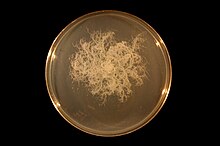
Bacillus is a genus of Gram-positive, rod-shaped bacteria, a member of the phylum Bacillota, with 266 named species. The term is also used to describe the shape (rod) of other so-shaped bacteria; and the plural Bacilli is the name of the class of bacteria to which this genus belongs. Bacillus species can be either obligate aerobes which are dependent on oxygen, or facultative anaerobes which can survive in the absence of oxygen. Cultured Bacillus species test positive for the enzyme catalase if oxygen has been used or is present.

Pseudomonadota is a major phylum of Gram-negative bacteria. The renaming of phyla in 2021 remains controversial among microbiologists, many of whom continue to use the earlier names of long standing in the literature. The phylum Proteobacteria includes a wide variety of pathogenic genera, such as Escherichia, Salmonella, Vibrio, Yersinia, Legionella, and many others. Others are free-living (nonparasitic) and include many of the bacteria responsible for nitrogen fixation.

Bacillus cereus is a Gram-positive, rod-shaped, facultatively anaerobic, motile, beta-hemolytic, spore-forming bacterium commonly found in soil, food and marine sponges. The specific name, cereus, meaning "waxy" in Latin, refers to the appearance of colonies grown on blood agar. Some strains are harmful to humans and cause foodborne illness, while other strains can be beneficial as probiotics for animals. B. cereus bacteria are facultative anaerobes, and like other members of the genus Bacillus, can produce protective endospores. Its virulence factors include phospholipase C, cereulide, sphingomyelinase, metalloproteases, and cytotoxin K.

Bacillus megaterium is a rod-like, Gram-positive, mainly aerobic spore forming bacterium found in widely diverse habitats. It has a cell length of up to 4 µm and a diameter of 1.5 µm, which is quite large for a bacteria. The cells often occur in pairs and chains, where the cells are joined together by polysaccharides on the cell walls.
A Bacillus phage is a member of a group of bacteriophages known to have bacteria in the genus Bacillus as host species. These bacteriophages have been found to belong to the families Myoviridae, Siphoviridae, Podoviridae, or Tectiviridae. The genus Bacillus includes the model organism, B. subtilis, and two widely known human pathogens, B. anthracis and B. cereus. Other strains of Bacillus bacteria that phage are known to infect include B. megaterium, B. mycoides, B. pseudomycoides, B. thuringiensis, and B. weihenstephanensis. More than 1,455 bacillus phage have been discovered from many different environments and areas around the world. Only 164 of these phages have been completely sequenced as of December 16, 2021.

Bacillus anthracis is a gram-positive and rod-shaped bacterium that causes anthrax, a deadly disease to livestock and, occasionally, to humans. It is the only permanent (obligate) pathogen within the genus Bacillus. Its infection is a type of zoonosis, as it is transmitted from animals to humans. It was discovered by a German physician Robert Koch in 1876, and became the first bacterium to be experimentally shown as a pathogen. The discovery was also the first scientific evidence for the germ theory of diseases.
In bacteriology, a taxon in disguise is a species, genus or higher unit of biological classification whose evolutionary history reveals has evolved from another unit of a similar or lower rank, making the parent unit paraphyletic. That happens when rapid evolution makes a new species appear so radically different from the ancestral group that it is not (initially) recognised as belonging to the parent phylogenetic group, which is left as an evolutionary grade.
Bacillus pseudomycoides is a bacterium. The type strain is NRRL B-617T.
Caldalkalibacillus is an aerobic and spore-forming genus of bacteria from the family of Bacillaceae the stains either Gram-positive or Gram-variable. The type species of this genus is Caldalkalibacillus thermarum.
Metabacillus is a genus of rod-shaped bacteria exhibiting Gram-positive or Gram-variable staining in the family Bacillaceae within the order Bacillales. The type species for this genus is Metabacillus fastidiosus.
Neobacillus is a genus of rod-shaped bacteria that show Gram-positive or Gram-variable staining. This genus belongs under the family Bacillaceae within the order Bacillales. The type species of Neobacillus is Neobacillus niacini.
Cytobacillus is a genus of rod-shaped bacteria that stain either Gram-positive or Gram-variable in the family Bacillaceae within the order Bacillales. The type species for this genus is Cytobacillus firmus.
Alteribacter is a genus of Gram-positive or Gram-variable, rod-shaped bacteria in the family Bacillaceae within the order Bacillales. The type species for this genus is Alteribacter auranticus.
Ectobacillus is a genus of Gram-positive, rod-shaped bacteria in the family Bacillaceae within the order Bacillales. The type species for this genus is Ectobacillus panaciterrae.
Evansella is a genus of Gram-positive rod-shaped bacteria in the family Bacillaceae within the order Bacillales. The type species for this genus is Evansella cellulosilytica.
Ferdinandcohnia is a genus of rod-shaped bacteria that generally display Gram-positive staining in the family Bacillaceae within the order Bacillales. The type species for this genus is Ferdinandcohnia humi.
Heyndrickxia is a genus of Gram-positive rod-shaped bacteria in the family Bacillaceae within the order Bacillales. The type species for this genus is Heyndrickxia oleronia.
Litchfieldia is a genus of Gram-positive rod-shaped bacteria in the family Bacillaceae within the order Bacillales. The type species for this genus is Litchfieldia alkalitelluris.
Rossellomorea is a genus of Gram-Positive or Gram-variable staining rod-shaped bacteria in the family Bacillaceae from the order Bacillales. The type species of this genus is Rossellomorea aquimaris.
Sutcliffiella is a genus of Gram-Positive rod-shaped bacteria in the family Bacillaceae from the order Bacillales. The type species of this genus is Sutcliffiella cohnii.





